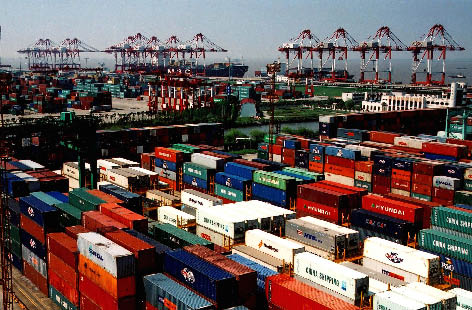| A Greener Approach to Port Logistics
By staff reporter LIU QIONG
Shanghai Port is one of the busiest in the world.
ARRIVING in Shanghai by sea, you see Shanghai Port, like other busy world ports, teeming with containers, hoists, and large cargo ships from all corners of the earth. Shanghai Port has the world’s largest cargo handling capacity and the second largest container handling capacity, and what’s more, leads globally in energy-efficiency of port logistics.
Baosteel Outsources Logistics, Saves Energy
Mineral powder and coal are offloaded onto conveyer belts and travel directly to their destination – the steel furnaces of the Pugang Company, part of the Baosteel Group. On another conveyer belt, Baosteel’s finished products arrive for loading onto foreign-bound vessels.
This is the modern logistics base jointly built by Shanghai Port and Baosteel. Here computerized management and distribution of raw materials and manufactured products make full use of the logistics enterprise, enabling the port operator and industrial enterprises to realize win-win.
It is common knowledge that the iron and steel industry is a big energy consumer, but few are aware of the energy appetite of logistics and transportation. Inbound iron ore and coal, and outbound steel products, consume huge amounts of expensive energy. Statistics show that of the procurement cost shouldered by Chinese iron and steel enterprises importing iron ore, logistics elements (transportation, storage and management) account for more than half.
“For a sharper competitive edge, it is imperative for iron and steel enterprises to optimize their logistics process so as to bring down costs and enhance economic performance,” says Zhang Chi of the Baosteel Group’s PR Department. The logistics involve multiple links, such as transportation, port, ship, brokerage and storage. The process is long and the operations complicated, making it hard to manage and control.
Overseas, specialist logistics operators have become the mainstay of modern logistics, whereas in China most industrial enterprises organize their logistics themselves. Only 18 percent of Chinese industrial enterprises outsource their raw materials logistics to a third party and only 16 percent do so with their manufactured products. In-house logistics systems have lowered the operational efficiency of China’s logistics industry, thereby aggravating wasteful consumption of energy and resources.
A specialist in port planning remarks that an iron and steel enterprise would usually construct its own wharf at the same time as building its plant, a very expensive approach that also prevents coastline resources being comprehensively used. Now Shanghai Port and Baosteel have jointly built a modern logistics base at Luojing, creating a new milestone in China’s port development.
| 
